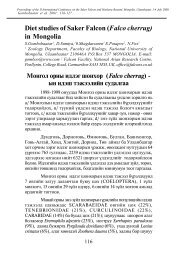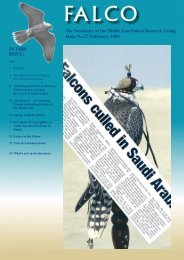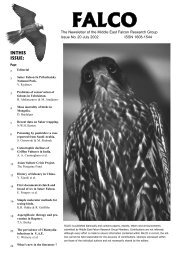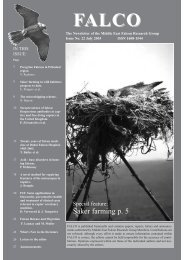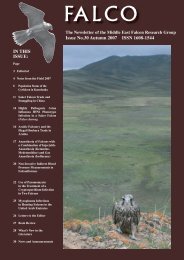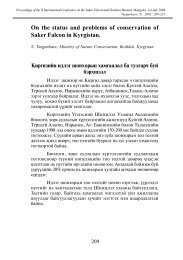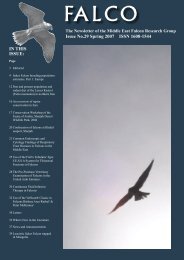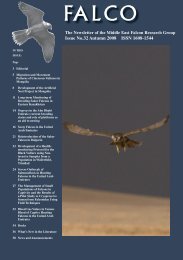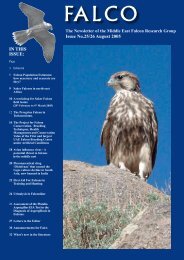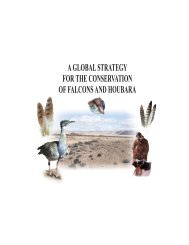Falco 28 - International Wildlife Consultants Ltd.
Falco 28 - International Wildlife Consultants Ltd.
Falco 28 - International Wildlife Consultants Ltd.
Create successful ePaper yourself
Turn your PDF publications into a flip-book with our unique Google optimized e-Paper software.
Figure 3. Flocks of Domestic Pigeons can attract hunting<br />
Saker <strong>Falco</strong>ns in winter.<br />
<strong>Falco</strong>ns at breeding and wintering sites is a threat to<br />
the Kyrgyz population. This is a serious problem and<br />
law enforcement is difficult. In the village where I had<br />
my base, one of my local contacts, a falconer, bought<br />
a Saker that had been recently caught ca. 70 km away.<br />
The reported price paid for this bird was ca. US$80.<br />
I was told that the reason for this low price was that<br />
the presence of avian flu in Central Asia had reduced<br />
the price of wild-caught falcons because fewer falcon<br />
dealers were now interested in buying these falcons. It<br />
was remarkable for me to experience the local Kyrgyz<br />
interest in this illegal trade and no doubt some of the<br />
people I spoke with were involved in illegal trapping.<br />
When asked about Saker <strong>Falco</strong>ns they knew exactly<br />
what I was looking for but they quickly realised that my<br />
focus was not on buying falcons but to study the wild<br />
birds. I received valuable information about breeding<br />
places and Saker habitats from these locals and it is<br />
clear many have a keen interest in birds of prey, so<br />
there is a little hope for future conservation.<br />
I saw no evidence of a<br />
wintering population of Sakers<br />
preying on the abundant duck<br />
population on Lake Issyk Kul.<br />
During my surveys I only saw<br />
Tolai Hare Lepus tolai and few<br />
species of mice as the majority<br />
of other small mammals were<br />
hibernating or hiding in grasslined<br />
nests feeding on food<br />
stored during the autumn. So,<br />
if there is a general lack of<br />
mammal prey it seems likely<br />
that avian prey is important<br />
for Sakers during wintertime.<br />
I have no direct observation of<br />
winter prey but I was told about<br />
an Italgir (Kyrgyz name for<br />
Saker) that preyed on domestic<br />
chickens. My local informants<br />
described how two Sakers<br />
usually sat for hours at nearby<br />
sandstone cliffs watching the<br />
chickens’ movements. I was<br />
also told by locals that in one<br />
village an escaped, or rather<br />
released, Saker preyed on<br />
pigeons. According to the story,<br />
this bird was released from<br />
captivity last summer because the owner didn’t know<br />
to feed his falcon properly. As it had almost starved to<br />
death he released it but apparently it didn’t possess the<br />
right skills for hunting and periodically it was found<br />
exhausted by villagers and given food. However, it<br />
apparently it became more skilled at hunting by autumn<br />
and preyed on a big flock pigeons (Figure 3). These<br />
anecdotes suggest that Sakers may hunt birds around<br />
villages in autumn and winter.<br />
Acknowledgements<br />
I would like to thank Environment Agency of Abu<br />
Dhabi (formerly ERWDA) and <strong>International</strong> <strong>Wildlife</strong><br />
<strong>Consultants</strong> (UK) <strong>Ltd</strong> for financial support. Mrs. Barbro<br />
Fox, Dr. Nick Fox and Dr. Andrew Dixon for scientific<br />
and moral support, and my Kyrgyz team; Luba, Sasha,<br />
Misha Danichkin for assisting me in the field.<br />
The absence of any Saker <strong>Falco</strong>n sightings during<br />
the transect surveys indicates that the species is not<br />
generally abundant in the Lake Issyk Kul region during<br />
winter, possibly because there is little food available.



